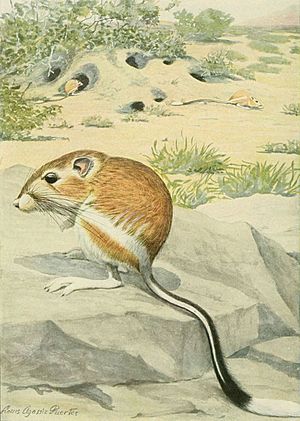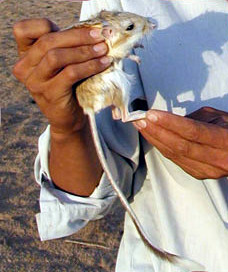Banner-tailed kangaroo rat facts for kids
Quick facts for kids Banner-tailed kangaroo rat |
|
|---|---|
 |
|
| Drawing by Louis Agassiz Fuertes | |
| Conservation status | |
| Scientific classification | |
| Genus: |
Dipodomys
|
| Species: |
spectabilis
|
The banner-tailed kangaroo rat (Dipodomys spectabilis) is a cool little rodent that lives in the desert. It's part of the Heteromyidae family, which includes other kangaroo rats and pocket mice. You can find these amazing creatures in dry areas of the southwestern United States and Mexico.
During the day, they chill in their burrows to stay safe from the heat and predators. At night, they come out to find seeds and plants to eat.
Contents
What Does It Look Like?
The banner-tailed kangaroo rat can grow to be about 34 cm (13 inches) long, including its tail. Its fur is a sandy, yellowish-brown color on its back, with some black hairs mixed in. Its belly is white.
The most special thing about this rat is its tail! It's bushy, has black bands, and a white tip. They wave it around like a flag or "banner," which is how they got their name.
These rats have super long back legs, much longer than their front legs. This helps them hop around really fast, just like a tiny kangaroo!
Where Do They Live?
The banner-tailed kangaroo rat lives in two separate areas in the southwestern United States and Mexico. The bigger group lives in dry parts of western Texas, Arizona, and northern New Mexico. They also live in Mexican states like Sonora, Chihuahua, and Zacatecas.
A smaller group lives mostly in the Mexican states of Aguascalientes and San Luis Potosí. These kangaroo rats love desert grasslands that have a few scattered bushes. They don't like areas where there are too many shrubs. If more than 20% of the ground is covered by bushes, they tend to move away.
How Do They Behave?
The banner-tailed kangaroo rat is a night owl, meaning it's active at night (nocturnal). It spends its days inside a complicated burrow system it digs underground.
As the rat digs and fixes its tunnels, it pushes out dirt, old bedding, and empty seed husks. This creates a special mound on the surface of the ground. These mounds can grow quite large over time. Scientists have seen mounds that are 3 meters (10 feet) wide and 40 cm (16 inches) high! Each burrow system is usually home to just one kangaroo rat. Sometimes, a tiny animal called the silky pocket mouse might share a burrow with them.
These rats mainly eat seeds and other parts of plants, especially grass seeds. They are expert hoarders! They collect extra food in their cheek pouches and store it in special chambers inside their burrows. They are known to be the best at storing food among all kangaroo rats.
Scientists have used radio trackers to study these rats. They found that each rat has a home area of about 450 square meters (4,840 square feet). These areas might overlap a little with their neighbors. Kangaroo rats usually leave their burrows shortly after sunset. They quickly hop to their feeding spots, eat for a few hours, and then rush back to their burrows. They might have another burst of activity a couple of hours before the sun comes up. The food they gather, like seed heads and grass clumps, is stored in layers in their burrow chambers, which can be up to 25 cm (10 inches) wide.
The banner-tailed kangaroo rat also uses its feet to drum on the ground. They do this to protect their territory. They even make a different drumming sound when they spot predators, like a gopher snake. This foot-drumming isn't usually to warn other kangaroo rats nearby. Instead, it seems to tell the predator that the rat is alert and ready, making it harder for the predator to catch them.
What's Their Status?
The banner-tailed kangaroo rat needs a very specific type of home. Its habitat is threatened when open desert grasslands are taken over by plants like creosote bush and mesquite.
Even though they are common in some places, their overall numbers are going down. Because of this, the IUCN lists them as "Near Threatened". This means they could become endangered if things don't improve.
See also
 In Spanish: Dipodomys spectabilis para niños
In Spanish: Dipodomys spectabilis para niños



